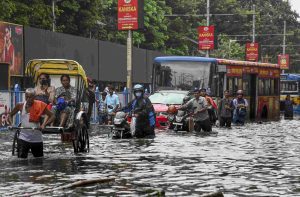Kolkata – The devastating impact of Kolkata heavy rains became tragically apparent as at least 10 people died, primarily from electrocution, following overnight downpours that brought the city to a complete standstill. The unprecedented rainfall measuring 251.4mm in less than 24 hours represents the highest precipitation since 1986 and ranks as the sixth-highest single-day rainfall in Kolkata’s recorded 137-year meteorological history.
The Kolkata heavy rains created widespread waterlogging across both northern and southern sections of the city, leaving vehicles stranded for hours in knee-to-waist-deep water at major intersections including Park Circus, Gariahat, Behala, and College Street. The catastrophic flooding has paralyzed normal urban life and exposed critical infrastructure vulnerabilities.
Historical Context and Meteorological Significance

The recent Kolkata heavy rains surpass most historical precipitation records, falling short only of the all-time record of 369.6mm set in 1978, along with previous significant rainfall events of 259.5mm in 1986 and 253mm recorded in 1888. This places the current weather event among the most severe in the city’s modern history.
Kolkata Mayor and state Urban Development Minister Firhad Hakim confirmed that the Kolkata heavy rains have affected most parts of the city, with Kolkata Municipal Corporation teams working around the clock to manage drainage operations. However, the overwhelming volume of water has exceeded the city’s drainage capacity, creating a cascading crisis.
Chief Minister’s Response and CESC Criticism


Chief Minister Mamata Banerjee characterized the Kolkata heavy rains as “unprecedented” while directing sharp criticism toward the Calcutta Electric Supply Corporation (CESC) for inadequate infrastructure maintenance. She specifically blamed poor dredging of the Farakka and systematic lapses by the power utility company for exacerbating the crisis.
“Electricity is supplied by CESC, not us. It is their duty to ensure people do not suffer because of this. They will do business here, but not modernise here? They should send people to the field and fix this,” Banerjee stated, highlighting the tension between public safety and private utility responsibilities during the Kolkata heavy rains emergency.
Transportation System Collapse

The Kolkata heavy rains have severely disrupted all forms of transportation throughout the metropolitan area. Traffic movement became virtually impossible across arterial roads, with vehicles stranded for extended periods in knee-to-waist-deep water at critical intersections and major thoroughfares.
Long traffic jams were reported on EM Bypass, AJC Bose Road, and Central Avenue, while numerous smaller lanes in south and central Kolkata were completely inaccessible due to waist-deep flooding. The Kolkata heavy rains forced commuters to abandon normal travel patterns as buses broke down and taxi services either suspended operations or implemented surge pricing.
Also Read: New Town Road Fatalities: Fourth Death in a Month Sparks Road Safety Alarm
Metro and Railway Service Disruptions
The Kolkata heavy rains caused significant disruption to metro rail services, with waterlogging reported in the mid-section of the Blue Line between Mahanayak Uttam Kumar and Rabindra Sarobar stations. Metro Railway Kolkata suspended services between Shahid Khudiram and Maidan stations as a safety precaution, implementing truncated services on unaffected sections.
Eastern Railway services suffered extensive disruptions due to the Kolkata heavy rains, with train movement suspended in the Sealdah south section and skeleton services maintained in Sealdah north and main sections. Circular Railway line operations were completely suspended due to waterlogging at Chitpur yard, affecting connectivity across the metropolitan region.
Aviation Impact and Flight Cancellations
Air travel faced severe disruption as the Kolkata heavy rains affected airport operations, resulting in at least 30 flight cancellations and 31 delayed departures. The combination of poor visibility, waterlogged access roads, and operational safety concerns created cascading effects on both domestic and international flight schedules.
Educational Institution Closures
Following Chief Minister Banerjee’s appeal for people to avoid waterlogged roads to prevent electrocution accidents, State Education Minister Bratya Basu announced comprehensive school closures. All government-run educational institutions will remain closed on September 24 and 25 due to the Kolkata heavy rains crisis.
“An unprecedented calamity-like situation prevails in the state,” Basu explained, emphasizing student safety concerns and instructing educational staff to work from home during the emergency period. Calcutta University and Jadavpur University have also suspended academic activities indefinitely.
Regional Rainfall Distribution


The Kolkata heavy rains showed significant variation across different city areas, with Garia Kamdahari recording the highest precipitation at 332mm, followed by Jodhpur Park at 285mm. Kalighat measured 280mm, Topsia recorded 275mm, and Ballygunge experienced 264mm, while northern areas like Thantania received comparatively lower amounts at 195mm.
Weather Forecast and Continuing Threats
The India Meteorological Department warns that the Kolkata heavy rains crisis may continue, with a low-pressure area over the northeast Bay of Bengal expected to bring additional heavy rainfall to several south Bengal districts. Heavy precipitation is forecast for Purba and Paschim Medinipur, South 24 Parganas, Jhargram, and Bankura districts through Wednesday.
Meteorologists predict another fresh low-pressure system may form over the east-central and adjoining north Bay of Bengal around September 25, suggesting the Kolkata heavy rains pattern could persist, requiring sustained emergency response and infrastructure improvements to prevent future casualties.

